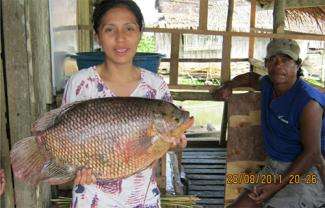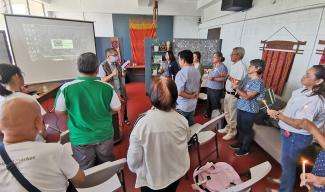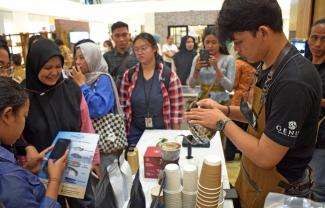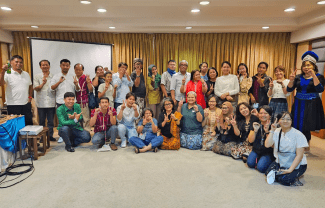Just about 10 months ago, the Manobos living in Sitio Panlabuhan, in Loreto, Agusan del Sur (Mindanao, Philippines) would not be able to eat if they could not catch fish from the Agusan Marsh in one day. Now, the tribal families are starting to feel confident that even if they are not able to harvest in three days' time, they will still be able to provide themselves with rice to eat.
This is the story of the Tribong Manobo of Sitio Panlabuhan, Loreto, Agusan Marsh Organization (TMOSPLAMO), one of the IP community grantees of the Indigenous Peoples Support Fund (IPSF) Project of Samdhana. The floating community of around 200 people is only four kilometers from the poblacion (village center), but it is only accessible by riding a banca (small wooden boat) in a 3 †4 hours trip from Bunawan, which is just the same as on walking on foot.
Their main source of livelihood is fishing, and one is able to harvest a good quality of endemic fish, like casili (freshwater eel Anguilla sp.) and some of the food fish that have already been introduced, like the giant gourami (Osphronemus gouramy)and tilapia.
Even with this bounty and the rich biodiversity and beauty of Agusan Marsh, the Manobo tribe is living in dire poverty. As with other isolated tribes, the people do not have the capacity to bring their products to the market and trade for themselves. They were being monopolized by fish traders who would buy their catch wholesale at very low prices.
They were hostaged with their “perennial debt†from these middlemen who took advantage of the tribe people's lack of business skills. Thus the community does not earn enough cash for other needs like rice or vegetables, including education. Added to that is the great distance and inaccessibility among the obstacles of getting education; they are not able to read or write, not even their names. They see their children growing up to become trapped in the same situation, as the young kids cannot risk the long trip back and forth to school. They are forced to dedicate their time to working instead of learning to improve their lives.
They submitted a proposal to Samdhana for the basic education of their preÂâ€schoolers. When Edtami, Samdhana Fellow and Adviser, and Ferdie, Samdhana Community Facilitator visited the area, they saw more than just the need for education; they saw how the tribe was being oppressed by the prevailing commercial system, and the lack of attention from the local government. They also witnessed the people's determination to rise above their situation, and the leadership and initiative of the women of the community. They saw great opportunity in the available natural resources of the community and how this can be tapped to make them independent and empowered. A Christian priest had donated a floating lodge for the community to receive occasional visitors to the Marsh. There is potential for developing a conservationÂâ€based ecoÂâ€tourism, wherein the community is crucial in helping to maintain the biodiversity of the Agusan Marsh, as well as to educate their neighbors and other visitors about it. In the immediate area, the Marsh is under threat of getting destroyed as peatlands are being cleared for agriculture, while a manmade canal drains water from the Marsh and allows silt from the Umayam River to penetrate the area.
With their grant from Samdhana, the community is now learning to manage their natural resources. They have identified their fishing grounds and agreed on their policy that they will not do electric fishing (the use of electricity to catch fish and other creatures). They will learn to increase their fish production in a sustainable manner by learning to culture endemic fish species, and the use of natural fish feeds. Thru Samdhana's assistance, the community will be taught the technology of hydroponics to grow their own vegetables. With the women taking the lead, they are now able to conduct business with the fish traders on more equal grounds, having paid off their debts and creating their community policy in dealing with traders. They are working to renovate and reinforce their multiÂâ€purpose center so that they are able to use this for preschool education, and at the same time, this will be the community's Biodiversity Learning Center. The overgrowth of water hyacinth is being maximized as a floater for their floating garden. Soil is placed on top on the hyacinth and plant vegetables there. In the months to come, each family will be able to establish their own floating garden. They have also identified and delineated 30 hectares within their area to become a specially protected conservation.
The entry of the project has facilitated to strengthen the governance of TMOSPLAMO, by organizing the community members to take part in the project. It has also served as an entrypoint to rebuild the community's relationship with the Head Claimant of their Ancestral Domain, and trigger discussions on reviving and strengthening of their traditional selfâ€governance. (TMOSPLAMO is just one sector of the Agusan Marsh Manobo tribe, which has successfully claimed their Ancestral Domain title). What is admirable is that the women of the tribe have shown a fiery spirit in facing their challenges; and they have spoken out to defend themselves and to improve their situation. The project has another seven months to go, and there is a lot of promise and excitement of the things that can be possibly achieved and the lives that could possibly be changed.
The Agusan Marsh, listed under the Ramsar Convention of Wetlands, is one of the most ecologically significant sites in the Philippines (See http://whc.unesco.org/en/tentativelists/5023/ and http://www.freewebs.com/2007agusanmarshcon/Presentations/Primaveraâ€Tumanda%20May%202007.pdf for more details). It is an important habitat for a multitude of fishes and birds, and performs important hydrological functions for Butuan City and the surrounding areas downstream. The Agusan Marsh is affected by siltation, pollution and invasion of exotic species, such as the janitor fish (Loricarid catfish family), among others.




